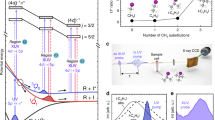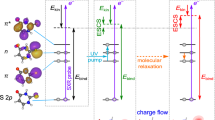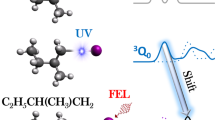Abstract
Donovan and Husain1–7 have recently carried out a number of investigations on electronically excited iodine and bromine atoms, I(52P1/2) and Br(42P1/2), by kinetic spectroscopy in absorption in the vacuum ultra-violet after flash photolysis of a number of gaseous halides. The long mean radiative life-times of these excited atoms8 arising out of the electric dipole forbidden transitions to the ground states, I(52P3/2) and Br(42P3/2), have facilitated such studies in absorption. This communication describes the study of the time resolved emission I(52P1/2) → I(52P3/2) + hv (1.315μ) following the flash photolysis of gaseous trifluoroiodomethane (CF3I), monitored by means of a lead sulphide photoconductive cell placed at the exit slit of a high aperture grating monochromator (Bausch and Lomb, f 4.4) and displayed on the screen of an oscilloscope. The concentrations of excited iodine atoms produced on photolysis2 are sufficiently high to overcome the low value of the Einstein coefficient for spontaneous emission, and adequate intensities are thus obtained. A typical trace for the decay of the emission is shown in Fig. 1. The decay is slower for increasing pressures of argon in accordance with a process primarily controlled by diffusion to the walls of the reaction vessel2–4.
This is a preview of subscription content, access via your institution
Access options
Subscribe to this journal
Receive 51 print issues and online access
$199.00 per year
only $3.90 per issue
Buy this article
- Purchase on Springer Link
- Instant access to full article PDF
Prices may be subject to local taxes which are calculated during checkout
Similar content being viewed by others
References
Donovan, R. J., and Husain, D., Nature, 206, 171 (1965).
Donovan, R. J., and Husain, D., Trans. Faraday Soc., 62, 11 (1966).
Donovan, R. J., and Husain, D., Trans. Faraday Soc., 62, 1050 (1966).
Donovan, R. J., and Husain, D., Trans. Faraday Soc., 62, 2053 (1966).
Donovan, R. J., and Husain, D., Nature, 209, 609 (1966).
Donovan, R. J., and Husain, D., Trans. Faraday Soc., 62, 2643 (1966).
Donovan, R. J., and Husain, D., Trans. Faraday Soc., 62, 2987 (1966).
Garstang, R. H., J. Res. Nat. Bur. Stand., A68, 61 (1964).
Mitchell, A. C. G., and Zemansky, M. W., Resonance Radiation and Excited Atoms, 247 (Cambridge University Press, 1934).
Hirschfelder, J. O., Curtiss, C. F., and Bird, R. B., Molecular Theory of Gases and Liquids, 539, 567 and 1110 (Wiley, New York, 1954).
Cadman, P., Polanyi, J. C., and Smith, I. W. M., paper delivered at the Meeting of American Chemical Society on Chemical Lasers, New York (1966).
Kasper, J. V. V., and Pimentel, G. C., App. Phys. Lett., 5, 231 (1964).
Kasper, J. V. V., Parker, J. H., and Pimentel, G. C., J. Chem. Phys., 43, 1827 (1965).
Author information
Authors and Affiliations
Rights and permissions
About this article
Cite this article
HUSAIN, D., WIESENFELD, J. Study of Electronically Excited Iodine Atoms I(52P1/2) by Time Resolved Emission. Nature 213, 1227–1228 (1967). https://doi.org/10.1038/2131227a0
Received:
Revised:
Issue Date:
DOI: https://doi.org/10.1038/2131227a0
Comments
By submitting a comment you agree to abide by our Terms and Community Guidelines. If you find something abusive or that does not comply with our terms or guidelines please flag it as inappropriate.



